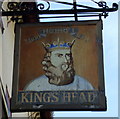1
White Hart Street, Thetford
It is hard to imagine that this narrow street was once the main road from London to Norwich. Today it is a cul de sac for traffic and consists of a mixture of independent shops, cafes, pubs and houses. The tower belongs to St Peter's church.
Image: © Stephen McKay
Taken: 14 Jan 2007
0.01 miles
2
The old theatre
12 & 14 White Hart Street, two grade II listed buildings, with number 14 being a theatre until 1833
Image: © Richard Croft
Taken: 6 Sep 2013
0.01 miles
3
Thetford houses [10]
Number 20 White Hart Street was built in the early 18th century with a gault brink front over a flint core. The bay to the left led to a passage to the rear with the entrance doorway off the passage. An extension at the rear was built and the passage became internal when the house was remodelled circa 1830. Listed, grade II, with details at: https://historicengland.org.uk/listing/the-list/list-entry/1219276
Once the ancient capital of East Anglia, Thetford is a market town established at a crossing of the River Little Ouse. A major centre of Boudica’s Iceni tribe with an Iron Age fort. Later came a Norman castle and an important priory. Thetford is the birthplace of 18th century radical Thomas Paine, whose thinking encouraged American independence and the abolition of slavery. After World War II, Thetford became an "overspill town", taking people from London.
Image: © Michael Dibb
Taken: 8 Sep 2020
0.01 miles
4
Thetford houses [11]
Number 18 White Hart Street is an early 19th century house with a gault brick front to a flint core. Listed, grade II, with details at: https://historicengland.org.uk/listing/the-list/list-entry/1196093
Once the ancient capital of East Anglia, Thetford is a market town established at a crossing of the River Little Ouse. A major centre of Boudica’s Iceni tribe with an Iron Age fort. Later came a Norman castle and an important priory. Thetford is the birthplace of 18th century radical Thomas Paine, whose thinking encouraged American independence and the abolition of slavery. After World War II, Thetford became an "overspill town", taking people from London.
Image: © Michael Dibb
Taken: 8 Sep 2020
0.01 miles
5
Thetford buildings [6]
Number 14 White Hart Street was a theatre and shop until 1833. It then became two houses and a shop and was converted to offices in the late 20th century. The building now houses a day nursery. Built in the mid 18th century in flint and clunch, the building was refronted in gault brick and the shop front inserted in the late 18th century. Listed, grade II, with details at: https://historicengland.org.uk/listing/the-list/list-entry/1297788
Once the ancient capital of East Anglia, Thetford is a market town established at a crossing of the River Little Ouse. A major centre of Boudica’s Iceni tribe with an Iron Age fort. Later came a Norman castle and an important priory. Thetford is the birthplace of 18th century radical Thomas Paine, whose thinking encouraged American independence and the abolition of slavery. After World War II, Thetford became an "overspill town", taking people from London.
Image: © Michael Dibb
Taken: 8 Sep 2020
0.01 miles
6
King's Head, Thetford
Pub on White Hart Street adjacent to the Ancient House Museum.
Image: © Stephen McKay
Taken: 16 Dec 2007
0.01 miles
7
Sign for the Kings Head, Thetford
Image: © JThomas
Taken: 16 Jul 2015
0.01 miles
8
Thetford houses [8]
Number 29 White Hart Street was part of the King's Head coaching inn and has been converted into a separate dwelling. Built in the early 18th century and refronted in 1878 altered in the late 20th century. Listed, grade II, with details at: https://historicengland.org.uk/listing/the-list/list-entry/1196094
Once the ancient capital of East Anglia, Thetford is a market town established at a crossing of the River Little Ouse. A major centre of Boudica’s Iceni tribe with an Iron Age fort. Later came a Norman castle and an important priory. Thetford is the birthplace of 18th century radical Thomas Paine, whose thinking encouraged American independence and the abolition of slavery. After World War II, Thetford became an "overspill town", taking people from London.
Image: © Michael Dibb
Taken: 8 Sep 2020
0.01 miles
9
Thetford houses [9]
The Chantry, number 22 White Hart Street, was probably built in the early 17th century, remodelled in the late 17th century and the rear rebuilt in the early 19th century. Timber framed, mostly rendered but with a brick front. Some original internal features remain. Listed, grade II, with details at: https://historicengland.org.uk/listing/the-list/list-entry/1291530
Once the ancient capital of East Anglia, Thetford is a market town established at a crossing of the River Little Ouse. A major centre of Boudica’s Iceni tribe with an Iron Age fort. Later came a Norman castle and an important priory. Thetford is the birthplace of 18th century radical Thomas Paine, whose thinking encouraged American independence and the abolition of slavery. After World War II, Thetford became an "overspill town", taking people from London.
Image: © Michael Dibb
Taken: 8 Sep 2020
0.01 miles
10
Thetford: outside The King's Head
The Grade II listing for Theatre House, on the right, begins "Used as a theatre and shop until 1833, then two houses and shop, converted to offices late C20. Mid C18. Flint and clunch with a painted gault brick facade added late C18. Slate roof. Two storeys with a third in the attic. Three-bay facade withrusticated quoins. Late C18 shop front to left consisting of a C20 door and an original display window".
Image: © John Sutton
Taken: 6 Mar 2020
0.01 miles




![Thetford houses [10]](https://s3.geograph.org.uk/geophotos/06/71/37/6713747_68fbeaaa_120x120.jpg)
![Thetford houses [11]](https://s0.geograph.org.uk/geophotos/06/71/37/6713748_2db94903_120x120.jpg)
![Thetford buildings [6]](https://s2.geograph.org.uk/geophotos/06/71/37/6713754_7c35dc35_120x120.jpg)


![Thetford houses [8]](https://s1.geograph.org.uk/geophotos/06/71/33/6713337_c246af2c_120x120.jpg)
![Thetford houses [9]](https://s1.geograph.org.uk/geophotos/06/71/33/6713341_18aea877_120x120.jpg)
